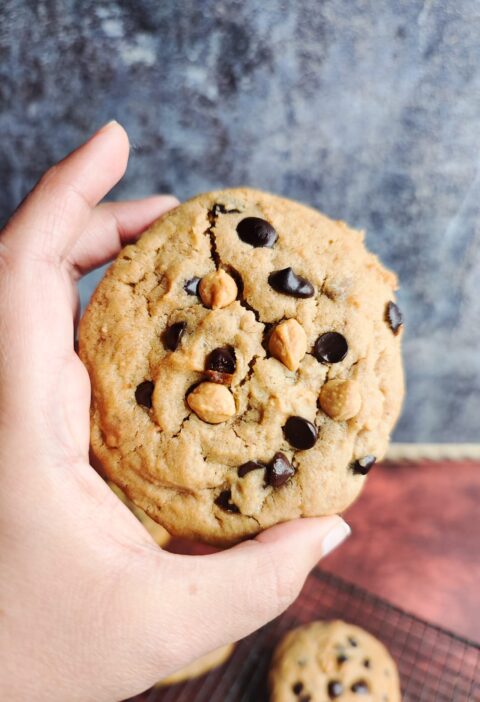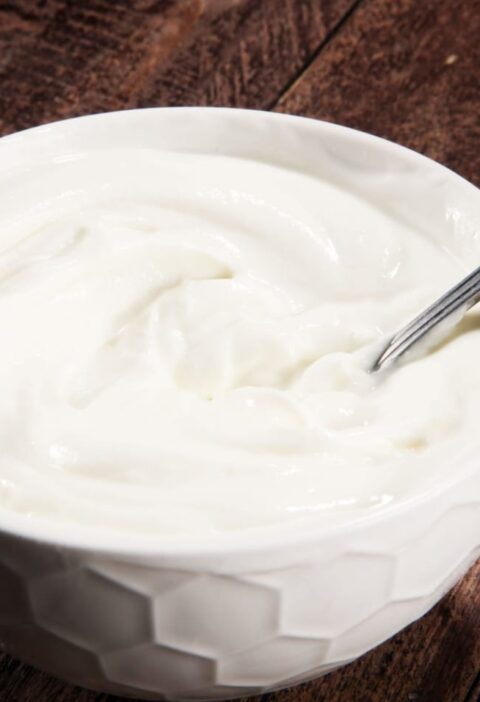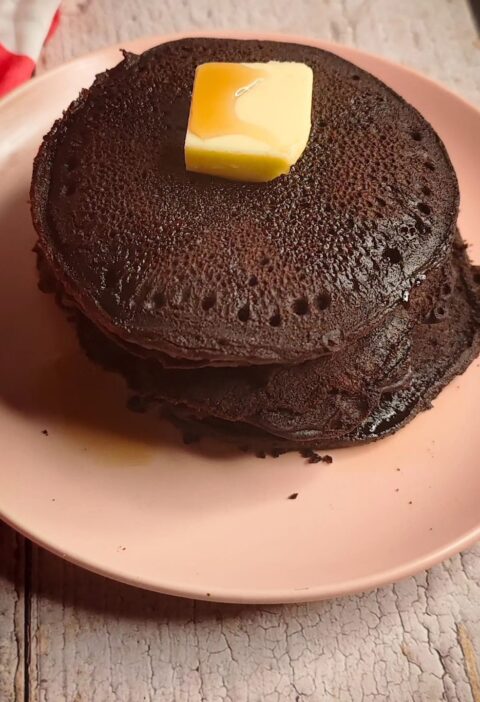This cookie doesn’t need an introduction, it’s one of the most popular cookies in the world and is enjoyed by all. Chocolate chip cookies are a delightful and timeless treat that has captured the hearts and taste buds of people all over the world. These delectable cookies are a perfect blend of sweet, buttery dough and luscious pockets of melted chocolate. Whether enjoyed fresh out of the oven or dunked in a glass of cold milk, chocolate chip cookies evoke a sense of comfort and indulgence that is hard to resist. Have you ever wondered how the cookie originated, how many types of chocolate chip cookies there are and what’s the science behind each type of chocolate chip cookie? You will get to read everything mentioned above and more. So brace yourself to read the best article on All about Chocolate Chip Cookies.

What is a chocolate chip cookie?
A chocolate chip cookie is a popular type of cookie that contains small chunks or chips of chocolate embedded within a sweet dough. It is characterized by its soft and chewy texture, buttery flavor, and the presence of melted chocolate in each bite.
The main components of a chocolate chip cookie include:
- Dough: The dough is made by combining ingredients such as flour, butter, sugar (both white and brown), eggs, vanilla extract, baking soda or powder, and salt. The dough is typically mixed until a smooth and cohesive mixture is formed.
- Chocolate Chips: Chocolate chips, usually semi-sweet or milk chocolate, are added to the dough. These small chunks of chocolate retain their shape during baking, providing pockets of melted chocolate and bursts of flavor throughout the cookie.
- Optional Ingredients: Some variations of chocolate chip cookies may include additional ingredients such as nuts (e.g., walnuts or pecans), oats, coconut flakes, or other flavorings to add texture and complexity to the cookie.
The dough is typically portioned into small rounds and baked in the oven until golden brown. The result is a delightful treat with a perfect balance of sweet dough and melted chocolate, offering a comforting and indulgent experience.
Chocolate chip cookies are a beloved classic, enjoyed by people of all ages and often served as a snack or dessert. They are widely available in bakeries, and grocery stores, and are commonly baked at home, allowing for variations and personal preferences in ingredients and texture.
How did the chocolate chip cookie originate?
The chocolate chip cookie, as we know it today, originated in the United States in the early 1930s. The invention of the chocolate chip cookie is credited to Ruth Graves Wakefield, who was the owner of the Toll House Inn in Whitman, Massachusetts.
According to popular legend, in 1937, Ruth Wakefield was preparing a batch of Butter Drop Do cookies when she realized she was out of baker’s chocolate. She substituted broken pieces of semi-sweet chocolate from Nestlé in the dough, thinking that they would melt and spread throughout the cookies. However, the chocolate chunks remained intact, creating the first chocolate chip cookies.
The cookies became an instant hit with the guests at the Toll House Inn, and Ruth Wakefield’s creation gained widespread popularity. In 1939, Nestlé (the chocolate manufacturer) struck a deal with Ruth Wakefield, and they printed her recipe on the back of their semi-sweet chocolate bar packaging. In return, Wakefield received a lifetime supply of Nestlé chocolate.
The popularity of the chocolate chip cookie continued to grow, and the recipe was widely shared and passed down through generations. Today, chocolate chip cookies are one of the most beloved and iconic cookies worldwide, enjoyed by people of all ages.
It’s worth noting that variations of cookies with chocolate chips or chunks existed prior to Ruth Wakefield’s creation. However, her adaptation of the recipe and the subsequent partnership with Nestlé played a significant role in popularizing and commercializing the chocolate chip cookie we know today.
Types Of Chocolate Chip Cookies
- Classic Chocolate Chip Cookies: These are the traditional cookies made with a basic dough consisting of flour, butter, sugar, eggs, vanilla extract, and chocolate chips.
- Chewy Chocolate Chip Cookies: These cookies are known for their soft and chewy texture. They often have a slightly higher moisture content, achieved by using more brown sugar and/or adding cornstarch to the dough.
- Crispy Chocolate Chip Cookies: Crispy cookies have a more delicate and crunchy texture. They typically have a higher ratio of butter to flour, resulting in a thinner and crisper cookie.
- Double Chocolate Chip Cookies: These cookies are loaded with extra chocolate flavor. In addition to chocolate chips, they incorporate cocoa powder or melted chocolate into the dough.
- Oatmeal Chocolate Chip Cookies: These cookies feature the addition of oats, which lend a chewy texture and a slightly nutty flavor. The combination of oats and chocolate chips creates a delightful contrast of textures.
- Peanut Butter Chocolate Chip Cookies: Peanut butter is added to the dough along with the chocolate chips, creating a delicious flavor combination. These cookies are often rich, and dense, and have a slightly softer texture.
- White Chocolate Chip Cookies: Instead of using traditional chocolate chips, these cookies are made with white chocolate chips. The creamy and sweet flavor of white chocolate adds a unique twist to the classic recipe.
- Vegan or Gluten-Free Chocolate Chip Cookies: These variations cater to specific dietary preferences or restrictions. Vegan chocolate chip cookies substitute ingredients like plant-based butter and flaxseed meal instead of eggs, while gluten-free versions use alternative flours like almond flour or rice flour.
These are just a few examples, but the world of chocolate chip cookies offers endless possibilities for creativity and experimentation. Feel free to explore and create your unique variations as well!
Science Behind the Chocolate Chip Cookies
Chocolate chip cookies are a beloved treat enjoyed by many people around the world. The science behind chocolate chip cookies involves several key factors that contribute to their texture, taste, and overall deliciousness. Here are some scientific aspects to consider:
- Ingredients: Chocolate chip cookies typically contain ingredients such as flour, sugar, butter, eggs, baking soda/powder, vanilla extract, and, of course, chocolate chips. Each ingredient plays a specific role in the cookie’s final outcome.
- Maillard Reaction: The Maillard reaction is a chemical reaction that occurs between amino acids and reducing sugars when heated. It is responsible for the browning and development of complex flavors in baked goods. In chocolate chip cookies, the Maillard reaction contributes to the golden-brown color and the rich, caramelized flavors.
- Leavening Agents: Baking soda and/or baking powder are used as leavening agents in chocolate chip cookies. They release carbon dioxide gas when exposed to heat, causing the cookies to rise and become light and airy.
- Butter: Butter provides moisture, flavor, and richness to the cookies. It also contributes to the texture by helping the cookies spread while baking. The fat in butter coats the flour proteins, inhibiting gluten formation and resulting in a more tender cookie.
- Sugar: Sugar adds sweetness and aids in the browning of cookies. It also plays a role in the texture by providing moisture and tenderness. Different types of sugar, such as brown sugar or granulated sugar, can affect the chewiness and moisture content of the cookies.
- Flour: Flour provides structure to the cookies through the formation of gluten when mixed with liquids. The amount and type of flour used can impact the texture of the cookies. More gluten development results in a chewier cookie, while less gluten leads to a softer, more tender texture.
- Chocolate Chips: The type and quality of chocolate used in chocolate chip cookies can greatly influence their taste and texture. The chocolate chips melt during baking, creating pockets of melted chocolate that contribute to the overall flavor and moisture of the cookies.
- Temperature and Time: Baking temperature and time are crucial factors. The right temperature ensures proper browning and even cooking, while the baking time affects the texture. Underbaking can result in a softer and chewier cookie while overbaking can make them crisp and dry.
- Cooling and Resting: Allowing the cookies to cool on a wire rack after baking is essential. During this time, the cookies firm up and develop their final texture. Resting the dough in the refrigerator before baking can also lead to improved texture and flavor, as it allows the flavors to meld and the dough to hydrate fully.
By understanding the science behind chocolate chip cookies, bakers can make informed decisions and adjustments to achieve the desired texture, flavor, and appearance in their homemade treats.
What is Maillard’s Reaction? How does it work in chocolate chip cookies?
The Maillard Reaction for chocolate chip cookies happens at 310 degrees when the sugar combines with amino acids that come from protein. The magic happens when the sugar in amino acids reacts with the protein, they produce amazing chemical compounds that are responsible for the delicious smell, taste, and texture. In Chocolate Chip Cookie it so happens that one final reaction happens at 356 degrees this is where the sugar caramelizes due to the high temperature, it’s not like you will see the caramel ooze out of the cookie but what it would do is change the taste of the cookie all together and make it sweet and delicious. All these reactions happen within a time span of 10 minutes.
The major cookie-baking process looks like this-
- Fat: The fat content in the cookie dough, usually from butter, plays a significant role in spreading. As the cookies heat up in the oven, the fat melts and spreads, causing the dough to spread outwards. A higher ratio of fat to flour will result in more spread.
- Sugar: The sugar content affects the spread of cookies as well. Sugar absorbs moisture from the dough, causing it to liquefy and spread during baking. Cookies with higher sugar content tend to spread more than those with lower sugar content.
- Leavening Agents: Baking soda and baking powder release carbon dioxide gas when exposed to heat. This gas production creates pockets of air within the dough, leading to expansion and spreading. An increase in the number of leavening agents can contribute to the spread of the cookies.
- Moisture Content: The moisture content of the dough influences the spread of cookies. Higher moisture levels result in more spreading. Ingredients such as eggs, liquid sweeteners, and even higher moisture ingredients like brown sugar or molasses contribute to increased moisture in the dough.
- Flour Protein Content: The protein content in flour affects the structure of the cookie dough. Flours with higher protein content, such as bread flour, promote more gluten formation. Gluten provides structure and elasticity to the dough, reducing the spread. On the other hand, lower protein flours like all-purpose flour or cake flour result in a softer and more tender texture with more spread.
- Temperature: Baking at higher temperatures causes the fat in the dough to melt quickly, resulting in faster spreading. Lower baking temperatures give the dough more time to set before the fat fully melts, resulting in less spread. At 212 F the water in the cookie turns into steam and the vapors push through the dough finally the baking powder or soda reacts with the steam and produces carbon dioxide which finally helps the dough rise. All this leaves holes in the cookie dough or ball and that’s the reason they are well risen and flaky and light.
- Dough Thickness: The thickness of the cookie dough can impact spreading. The thicker dough will take longer to heat through and spread, resulting in less spread. Thinner dough will heat up and spread more quickly, resulting in more spread.
How do we achieve specific textures in cookies, such as soft, crunchy, Chewey, or cakey?
Here’s a breakdown of the science behind each texture:
- Soft Cookies:
- Flour: Use a higher proportion of all-purpose flour, which has a lower protein content compared to bread flour. This helps to create a more tender texture. A common ratio is around 2 1/4 cups (280 grams) of all-purpose flour.
- Fat: Increase the amount of fat in the recipe. This can be achieved by using a higher ratio of butter. A common ratio is around 1 cup (226 grams) of softened butter. Alternatively, you can incorporate additional fats like vegetable oil or shortening to enhance the softness.
- Sugar: Use a higher ratio of brown sugar, which contains molasses and contributes to moisture retention and softness. Brown sugar also adds a subtle caramel flavor. A common ratio is around 3/4 cup (150 grams) of brown sugar. You can also add a smaller amount of white sugar (around 1/2 cup or 100 grams) for sweetness.
- Eggs: Use a slightly higher ratio of eggs. Eggs provide moisture and tenderness to the cookies. For soft cookies, you can use 2 large eggs or an additional egg yolk along with 1 whole egg.
- Liquid: Incorporate a small amount of liquid to keep the cookies moist. This can be achieved by adding a teaspoon of milk or a tablespoon of heavy cream to the dough.
- Leavening Agents: Use a smaller amount of leavening agents, such as baking soda or baking powder. This helps control the rise of the cookies, resulting in a softer texture. Around 1 teaspoon of baking soda or baking powder is commonly used.
- Crunchy Cookies:
- Flour: Increase the amount of flour to create a sturdier structure in the cookies. Adding more flour will absorb more moisture, resulting in a drier and crispier texture. You can try increasing the flour by approximately 1/4 to 1/2 cup more than the standard recipe.
- Sugar: Increase the amount of granulated or white sugar in the recipe. Granulated sugar contains less moisture than brown sugar, which contributes to a crisper texture. You can add a slightly higher proportion of granulated sugar compared to brown sugar for a more pronounced crunch.
- Butter: Increase the amount of butter in the recipe. Butter provides richness and flavor but also contributes to spreading during baking. More butter will result in thinner cookies that tend to be crispier. You can try adding an additional tablespoon or two of butter to the recipe.
- Baking Time and Temperature: Extend the baking time to allow the cookies to dry out and become crisp. Keep an eye on the cookies as they bake and adjust the time accordingly. You may need to increase the baking time by a few minutes until the cookies turn golden brown and have a crisp texture. Additionally, baking the cookies at a slightly lower temperature (around 325°F to 350°F or 160°C to 175°C) can help promote a crunchier texture.
- Remember, these ratios are suggestions, and you can adjust them based on personal preference.
- Cakey Cookies:
- Flour: Increase the amount of flour in the recipe. Adding more flour helps create a denser structure and contributes to a cakey texture. You can try increasing the flour by approximately 1/4 to 1/2 cup compared to a standard recipe.
- Fat: Use less fat in the recipe. While fat contributes to tenderness and moisture in cookies, reducing the fat content can help achieve a cakey texture. You can slightly decrease the amount of butter or substitute part of the butter with a liquid fat such as vegetable oil.
- Leavening Agents: Increase the amount of leavening agents, such as baking powder or baking soda, to promote more rising during baking. This will help create a lighter and cake-like texture. You can add an extra teaspoon of baking powder or baking soda to the recipe.
- Liquid: Increase the amount of liquid in the dough. This helps create a softer and more cakey texture. You can add a small amount of milk or water to the dough, about 1 to 2 tablespoons, to increase the moisture content.
- Sugar: Use a combination of granulated sugar and brown sugar. Brown sugar adds moisture and tenderness to the cookies, contributing to a cakey texture. You can increase the amount of brown sugar slightly compared to white sugar.
- Remember, these ratios are general guidelines, and you can adjust them according to your preferences.
- Chewey Cookies:
- Fat: Use a higher ratio of fat to flour. This typically means increasing the amount of butter in the recipe. A common ratio is around 1 cup (226 grams) of butter for 2 1/4 cups (280 grams) of flour.
- Sugar: Use a higher proportion of brown sugar compared to white sugar. Brown sugar contains molasses, which adds moisture and contributes to a chewy texture. A typical ratio is around 3/4 cup (150 grams) of brown sugar to 1/2 cup (100 grams) of white sugar. You can adjust these ratios to your preference.
- Eggs: Use a slightly higher number of egg yolks or a combination of whole eggs and extra yolks. Egg yolks contain more fat and help contribute to a richer and chewier texture. Adding an extra yolk to the dough can enhance the chewiness.
- Flour: Use a combination of all-purpose flour and cake flour. All-purpose flour provides structure, while cake flour has a lower protein content and results in a softer and more tender texture. A common ratio is 2 parts all-purpose flour to 1 part cake flour.
- Leavening Agents: Use a minimal amount of leavening agents like baking soda or baking powder. Too much leavening can cause the cookies to rise and become cakey rather than chewy. Use around 1/2 teaspoon of baking soda or baking powder for a recipe that yields about 2 dozen cookies.
- Remember that these ratios are not strict rules but rather guidelines. You can adjust the ratios based on personal preference and desired outcome.
Remember that these factors interact with each other, so adjusting one aspect may impact others. It’s essential to experiment with ingredient proportions and baking techniques to achieve the desired texture in your cookies.
I have by choice left out any information about how to make chocolate chip cookies eggless as I feel that this subject deserves a blog post of its own. Please tell me in the comments below whether you would like an article on eggless chocolate chip cookies.
I hope this article has helped you to understand chocolate chip cookies like never before. I am sure if you read and work on the given guidelines you can form your own amazing chocolate chip cookie recipe. If you have found this article helpful, please leave a comment and like and subscribe to my website. I hope you all enjoy baking chocolate chip cookies with family and this article helps you grow in your baking journey. Love Nari







